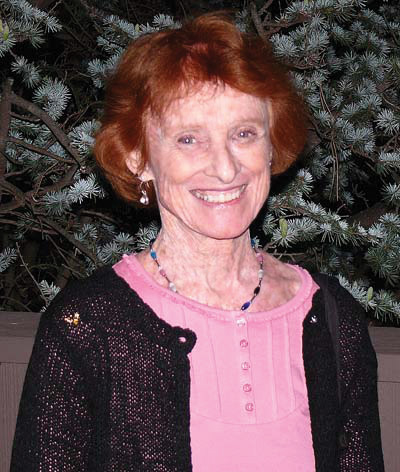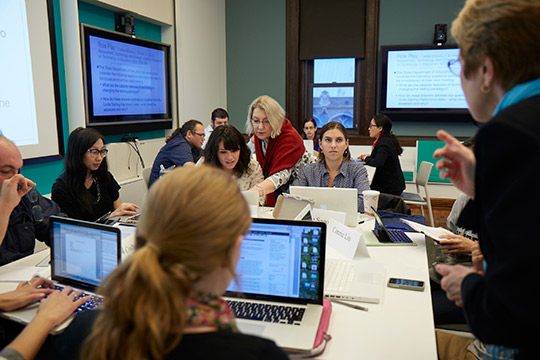Even the Classrooms Are Smart
TC's high-tech campus makeover aims to realize Dewey's century-old vision of teaching
With its heavy oak doors and window casements, 16-foot ceilings and varnished wood floors, Teachers College’s Horace Mann Hall conjures visions of bearded men in monocles and stiff collars lecturing to rows of obedient listeners.
But not HM 438. One chilly evening last fall, students in Ellen Meier’s class on Technology and School Change clustered around conference tables of gleaming white board, watching a video on monitors on all four walls about an Internet app that enables real-time sharing of content from any smart device. Then they divided into teams to develop technology-driven plans to help hypothetical schools create more dynamic, collaborative learning environments.
After a digital stopwatch on the monitors ticked to a halt, the teams wirelessly projected their presentations from laptops onto the wall screens. Kenny Graves, a professional development associate from TC’s Center for Technology and School Change, videotaped each presentation and displayed students’ digitally organized comments on a chart that would later be posted on the open-source learning platform, Moodle.
“A technology-rich classroom provides new tools for creating learning environments,” says Meier, who co-directs the Center and coordinates the College’s Educational Technology Specialist Program. “Using it involves rethinking traditional teaching and learning, but it’s exciting to create an environment where students explore ideas and construct understandings. We know that kind of active learning is most effective.”
Janine Bowes, an Australian school leader earning a master’s in Instructional Technology & Media, agrees. “This room enables students to teach and lead discussions, but the instructor must design that kind of learning. The technology won’t magically do it for you.”
A NEW FRAMEWORK FOR LEARNING
TC’s campaign Where the Future Comes First calls for the creation of more smart classrooms in the coming years. Because these additional spaces will be tailored to more specific uses, each room will offer variations on the features of the prototype in HM 438—but the intended result is every bit as dramatic.
“We have some of the leading minds in learning technology, so we must offer cutting-edge facilities,” says Harvey Spector, TC’s Vice President for Finance and Administration, who tapped New York City-based SHoP Architects to design HM 438. “The smart classrooms are central to our efforts to lead a revolution in teaching and learning.”
The essence of the revolution, says TC alumnus Matthew Pittinsky, founder of Blackboard and CEO of Parchment, is “the fact that we are interconnected through IP, through networks that break down barriers of time and space.”
HM 438 makes those connections happen. The room boasts two projectors, two PCs, four cameras for videoconferencing and four wall displays, two of which are touchscreen and use SMART Notebook software. The walls are movable sliding white board, and the 11 tables, on casters for easy reconfiguration, can be flipped up for presentations.
The room’s hardware and cables are hidden behind a shell within the original walls. “Technology changes rapidly,” says Spector, “but the architects’ plug-and-play design lets us quickly adapt to potential new applications without gutting the room.”
With its wireless connectivity, HM 438 often displays a live Twitter feed on one screen, a PowerPoint on another and handwritten instructions on a white board. Presenters can participate, virtually, from anywhere.
“One student in my class last summer had to leave early to teach in Taiwan,” recalls Adjunct Assistant Professor Tom Chandler (Ph.D. ’09), Associate Research Scientist at the National Center for Disaster Preparedness at Columbia’s Earth Institute. “He did his final presentation via Skype and using Google Earth. Our screens and sound are so high-quality, it felt like he was in the room.”
Chandler, who helped create TC’s landmark 2007 curriculum about Hurricane Katrina and its aftermath, is an expert on the role of geography in disasters. Maps are key in his TC course, which helps aspiring social studies teachers incorporate global energy sustainability issues into their teaching.
“To understand the scale of these problems and the solutions needed, you have to visualize information in new ways,” he says.
Chandler requires his students to take pictures of environmentally troubled local areas, such as the Superfund sites at Newtown Creek and the Gowanus Canal. In class, they further document what they’ve seen with Google Earth, which, through satellite and aerial photography captures details as small as specific streets and houses, and with real-time data on public health, weather and traffic.
“After Hurricane Sandy, they could really see the extent to which water contaminated by millions of gallons of toxic spillage flowed onto people’s property and caused them direct physical harm,” he says. Through census information and by using Google Earth to show geographic concentrations of people the census doesn’t name, the students can further spotlight the socioeconomic implications of disasters.
“Ultimately, this technology is all about the democratization of information,” Chandler says. “Students create their own visual interpretations of the world. It’s a profoundly powerful learning experience, and it dramatically changes their pedagogical practices, as well.”
NOT JUST FOR TECHIES
The subjects Meier and Chandler teach directly relate to technology. But can a smart classroom help faculty and students in English education or anthropology or languages?
“English or language teachers who think about using technology as a way to help build student knowledge will probably find creative uses for these tools,” says Meier. “It’s really not about the technology, per se, but rather how the technology helps support learning goals.”
Not long ago, Chandler saw students in his TC class messing with their cell phones while he was talking. “I thought they were texting friends,” he says. “But they were actually taking notes on their screens. So the question isn’t: ‘Why should I use this stuff,’ but rather: ‘How am I going to use it?’ Because our students are already there.”
SMART FUNDER
“I believe in the power of education,” says Amity P. Buxton (Ph.D. ’62, M.A. ’52), whose generous gift is funding a smart classroom at TC. “My trust in Teachers College is based on the fact that it continues to develop its training of excellent teachers to educate diverse populations,” says Buxton, who taught for 22 years in diverse urban districts. She also has supported the TC Peace Corps Fellows Fund, the TC Fund and the Amity Buxton Scholarship Fund. –Robin Eileen Bernstein
(Published 6/3/2014)
Published Tuesday, Jun. 3, 2014

